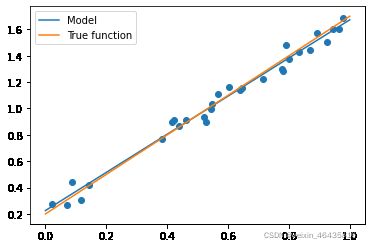机器学习-线性回归
线性回归
线性回归作为机器学习入门时候所学习的第一门课,结构简单,原理清晰。因此往往容易被学习者所忽视,其实线性回归虽然简单,但是确实一套具有很高的实战价值的算法,在很多的现实场景中有着非常广泛的应用。
线性回归模型
线性回归总结起来就是两个字:拟合,也就是通过调整直线方程的参数,使得所作直线拟合数据集点,从而达到趋近于理论点的过程。
线性回归的模型定义为:

代码实现
import numpy as np
import matplotlib.pyplot as plt
def true_fun(X): # 这是我们设定的真实函数,即ground truth的模型
return 1.5*X + 0.2
np.random.seed(0) # 设置随机种子
n_samples = 30 # 设置采样数据点的个数
'''生成随机数据作为训练集,并且加一些噪声'''
X_train = np.sort(np.random.rand(n_samples))
y_train = (true_fun(X_train) + np.random.randn(n_samples) * 0.05).reshape(n_samples,1)
from sklearn.linear_model import LinearRegression # 导入线性回归模型
model = LinearRegression() # 定义模型
model.fit(X_train[:,np.newaxis], y_train) # 训练模型
print("输出参数w:",model.coef_) # 输出模型参数w
print("输出参数b:",model.intercept_) # 输出参数b
通过运行模型并输出模型参数可以看到,线性回归拟合的参数是1.44和0.22,很接近实际的1.5和0.2,说明我们的算法性能还不错。
X_test = np.linspace(0, 1, 100)
plt.plot(X_test, model.predict(X_test[:, np.newaxis]), label="Model")
plt.plot(X_test, true_fun(X_test), label="True function")
plt.scatter(X_train,y_train) # 画出训练集的点
plt.legend(loc="best")
plt.show()
import numpy as np
import matplotlib.pyplot as plt
from sklearn.pipeline import Pipeline
from sklearn.preprocessing import PolynomialFeatures # 导入能够计算多项式特征的类
from sklearn.linear_model import LinearRegression
from sklearn.model_selection import cross_val_score
def true_fun(X): # 这是我们设定的真实函数,即ground truth的模型
return np.cos(1.5 * np.pi * X)
np.random.seed(0)
n_samples = 30 # 设置随机种子
X = np.sort(np.random.rand(n_samples))
y = true_fun(X) + np.random.randn(n_samples) * 0.1
degrees = [1, 4, 15] # 多项式最高次
plt.figure(figsize=(14, 5))
for i in range(len(degrees)):
ax = plt.subplot(1, len(degrees), i + 1)
plt.setp(ax, xticks=(), yticks=())
polynomial_features = PolynomialFeatures(degree=degrees[i],
include_bias=False)
linear_regression = LinearRegression()
pipeline = Pipeline([("polynomial_features", polynomial_features),
("linear_regression", linear_regression)]) # 使用pipline串联模型
pipeline.fit(X[:, np.newaxis], y)
scores = cross_val_score(pipeline, X[:, np.newaxis], y,scoring="neg_mean_squared_error", cv=10) # 使用交叉验证
X_test = np.linspace(0, 1, 100)
plt.plot(X_test, pipeline.predict(X_test[:, np.newaxis]), label="Model")
plt.plot(X_test, true_fun(X_test), label="True function")
plt.scatter(X, y, edgecolor='b', s=20, label="Samples")
plt.xlabel("x")
plt.ylabel("y")
plt.xlim((0, 1))
plt.ylim((-2, 2))
plt.legend(loc="best")
plt.title("Degree {}\nMSE = {:.2e}(+/- {:.2e})".format(
degrees[i], -scores.mean(), scores.std()))
plt.show()
